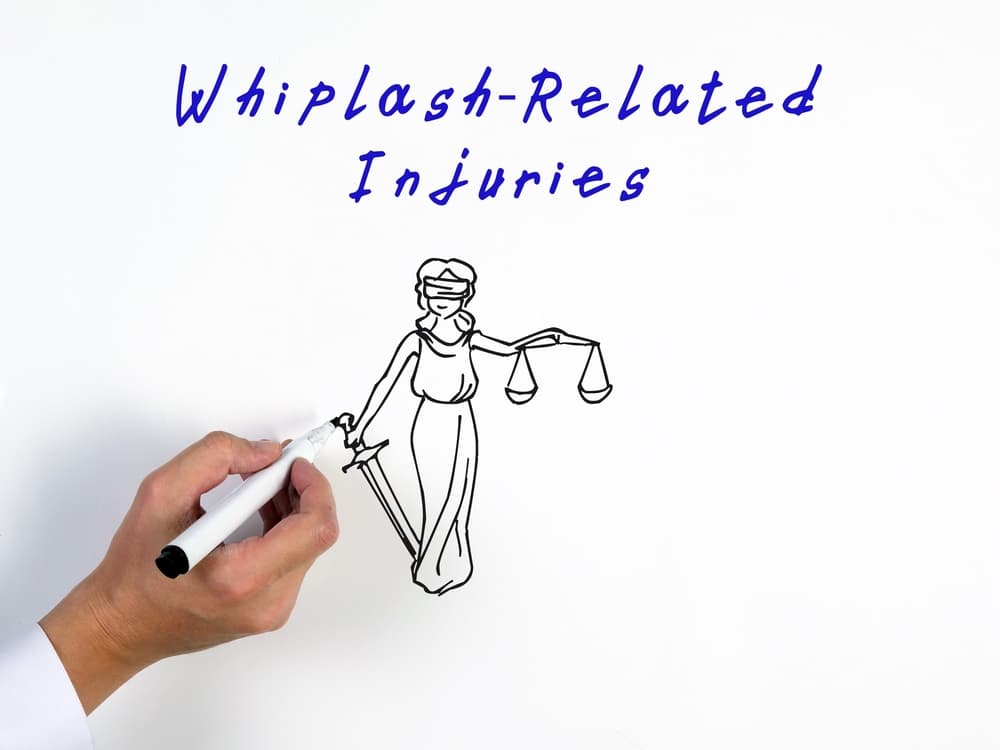Steven A. Bagen | July 25, 2024 | Car Accidents

Whiplash is a common neck injury resulting from car accidents. Determining the minimum compensation for whiplash can require an experienced lawyer.
If you’ve suffered a whiplash injury, contact the car accident lawyers from Bagen Law Accident Injury Lawyers at (800) 800-2575 for a free consultation to discuss your case and potential compensation.
Factors Affecting Whiplash Compensation

How Injury Severity Impacts Compensation
Minor whiplash injuries might fully recover within weeks or months, whereas severe cases can cause long-term pain and disability, warranting higher compensation. Severe injuries often lead to more extensive medical treatments, such as:
- Prolonged physical therapy
- Surgery
- Chronic pain management
- Rehabilitation programs
Why Some Whiplash Injuries Are Worse Than Others
Whiplash injuries can vary greatly in severity and duration. While defense lawyers and insurance companies might question the legitimacy of long-term whiplash claims, research explains why some people are more likely to suffer prolonged effects. Here are key factors that can influence the severity of whiplash injuries:
- Spine Curvature: The natural neck curve (cervical lordosis) can affect how badly whiplash hurts you.
- Collision Type: How the crash happens matters. Rear-end collisions often cause worse whiplash injuries than other types of accidents.
- Age: Older people may suffer more severe whiplash injuries. However, younger victims often receive higher compensation amounts.
- Pre-existing Conditions: Even if you don’t have symptoms, existing spinal issues can make whiplash worse.
- Previous Whiplash: If you’ve had whiplash before, you’re more likely to get it again and potentially more severely in future accidents.
- Surprise Factor: Not seeing the impact coming can lead to worse injuries.
Medical Expenses and Treatment Costs
Compensation typically covers all medical expenses related to the injury. This includes:
- Initial emergency room visits
- Diagnostic tests (X-rays, MRIs)
- Ongoing treatments (physical therapy, chiropractic care)
- Future medical procedures
- Prescription medications
- Specialist consultations
The more medical expenses the injured party incurs, the more compensation they may be entitled to.
Lost Wages and Income
Whiplash injuries often lead to missed workdays. Compensation can cover:
- Lost wages (including overtime and bonuses)
- Used sick leave and vacation days
- Future lost earnings (if the injury affects long-term employment prospects)
Pain and Suffering
Compensation for pain and suffering accounts for the physical pain and emotional distress caused by the injury. Factors include:
- Duration and intensity of pain
- Impact on daily activities
- Effect on quality of life
Credibility of the Plaintiff
Juries often rely heavily on the plaintiff’s credibility when deciding whiplash cases. Diagnostic imaging rarely reveals the full extent of whiplash injuries, so jurors must believe the plaintiff’s description of their pain and suffering to award a higher settlement. The plaintiff’s ability to convincingly communicate their experience typically plays the biggest role in determining the case’s outcome.
Quality of Legal Representation
Hiring an experienced whiplash lawyer can significantly affect the outcome of your case. Skilled attorneys can effectively present evidence, negotiate with insurance companies, and advocate for higher compensation both at trial and the settlement table.
Costs Associated With Whiplash
Minor Whiplash Cases
- Medical Costs: $2,500 to $10,000
- Characteristics:
- Quick recovery
- Low medical expenses
- Minor impact on daily life
Moderate Whiplash Cases
- Medical Costs: $10,000 to $30,000
- Characteristics:
- Significant pain
- Longer recovery periods
- Higher medical costs (physical therapy, specialist consultations)
- Impact on work and daily activities
Severe Whiplash Cases
- Medical Costs: $30,000 to $100,000 or more
- Characteristics:
- Chronic pain or permanent disability
- Extensive medical treatments (surgery, long-term rehabilitation)
- Major impact on quality of life and ability to work
- Future medical costs and ongoing care needs
Legal Considerations
Eligibility Criteria for Claims
To claim compensation for whiplash in Florida, you must prove that the other party’s negligence caused the accident. Key criteria include:
- Duty of Care: The other driver owed you a duty of care.
- Negligence: The other driver acted negligently.
- Causation: The negligence directly caused your whiplash injury.
- Damages: You suffered actual damages, such as medical expenses, lost wages, and pain and suffering.
PIP Insurance Coverage Limits
Florida’s PIP insurance covers up to $10,000 for medical expenses and lost wages. However, this amount will not cover severe injuries, necessitating further legal action against the at-fault party to cover additional costs.
Comparative Negligence
Florida follows a comparative negligence rule. This rule reduces your compensation if you share fault for the accident. The court will decrease your award by the percentage of blame it assigns to you.
Statute of Limitations
The statute of limitations for filing a personal injury claim in Florida is two years from the accident.
Proving Your Whiplash Claim
Gathering and Presenting Evidence
Strong evidence is needed for a successful whiplash claim. This includes
- Medical Records:
- Initial Emergency Visits: Documentation from any emergency room visits immediately following the accident.
- Diagnostic Tests: Results from X-rays, MRIs, and other diagnostic tests used to assess your injuries.
- Ongoing Treatments: Records of physical therapy sessions, chiropractic care, and any other ongoing treatments.
- Prescriptions and Medications: Detailed records of all prescribed medications and over-the-counter drugs used to manage pain and symptoms.
- Accident Reports: Official reports from the police or other authorities that detail the circumstances of the accident. These reports often include fault determination and witness observations .
- Photographic Evidence: Photos of the accident scene, vehicle damage, and any visible injuries can provide compelling visual proof of the impact and severity of the accident.
- Witness Statements: Statements from witnesses who saw the accident can corroborate your account and support your claim.
Seeking Legal Assistance
Why You Need a Lawyer for Your Whiplash Claim
A lawyer can help you navigate the legal process, negotiate with insurance companies, and potentially get you a better settlement.
Consider hiring a lawyer if:
- Your injuries are severe or long-lasting
- You’re facing high medical bills
- You’ve lost significant time at work
- The insurance company is disputing your claim
If you’re unsure whether you need a lawyer, many offer free consultations. During this meeting, you can discuss your case and get professional advice on how to proceed.
Insurance companies will minimize your claim., so consult a lawyer to understand your rights and options.
To seek legal help, look for a lawyer with experience in whiplash cases. They can guide you through the process and work to ensure you receive fair compensation for your injuries.
How a Personal Injury Lawyer Can Help
An experienced attorney can help:
- Gather Evidence: Collect and present essential documents, such as medical records, accident reports, and witness statements. This helps build a strong case to support your claim.
- Negotiate with Insurance Companies: Lawyers are skilled at countering insurance company tactics designed to minimize payouts. They can ensure that all aspects of your injury and losses are considered, aiming for a settlement that accurately reflects the true extent of your damages.
- Represent You in Court: If negotiations fail, your lawyer can advocate for you in court, ensuring that your rights are protected and you receive fair compensation for your injuries.
What to Expect During the Legal Process
The legal process for working with a lawyer on your whiplash claim involves several steps:
- Initial Consultation: Discuss your case with a personal injury lawyer to determine the viability of your claim.
- Evidence Gathering: Your lawyer will collect and organize evidence, including medical records, witness statements, and accident reports.
- Filing the Claim: The lawyer will file your claim with the appropriate court or negotiate directly with the insurance company.
- Negotiation: Your lawyer will negotiate with the insurance company to reach a fair settlement. If the insurance company offers a low settlement, your lawyer will advise you on the best action.
- Going to Trial: If a fair settlement cannot be reached, your lawyer will prepare to take your case to trial, representing you in court and advocating for maximum compensation.
No Win, No Fee Agreements
Many personal injury lawyers work on a contingency fee basis, meaning you only pay legal fees if you win your case. This arrangement reduces financial risk and ensures that your lawyer is motivated to secure the best possible outcome for your claim.
A contingency fee agreement typically includes:
- No Upfront Costs: You don’t pay any legal fees unless you receive a settlement or court award.
- Percentage of Settlement: The lawyer’s fee is a percentage of the compensation awarded, agreed upon before representation begins.
Whiplash Statistics

Prevalence and Incidence
Whiplash injuries are a significant public health concern in the United States. Each year, over 2 million Americans experience whiplash, and approximately 3 million new cases are reported annually. The National Highway Traffic Safety Administration (NHTSA) estimates that about 806,000 occupants sustain whiplash injuries in motor vehicle crashes yearly.
Economic Impact
Whiplash injuries impose substantial economic and quality of life costs, totaling over $9 billion yearly in the US. This figure includes medical expenses, lost productivity, and other related costs.
Long-term Effects
The long-term effects of whiplash can be severe and enduring. Between 15-40% of those injured in automobile accidents will struggle with chronic pain for the rest of their lives. Alarmingly, more than 50% of whiplash patients continue to experience chronic pain nearly 20 years after their accident. Furthermore, about 10% of individuals injured by whiplash become permanently disabled.
Injury Risk
The risk of injury in low-speed rear-impact collisions is reported to be between 35% and 68%. Most whiplash injuries occur at crash speeds below 12 miles per hour, which means that even minor accidents can lead to significant injuries.
Notably, there is no correlation between the extent of vehicle damage and the severity of the injury, indicating that whiplash can occur even when the vehicle shows minimal damage.
Recent Estimates
A recent study estimated that approximately 869,000 traffic crash-related cervical spine injuries are seen in US hospitals annually, including around 841,000 sprain/strain (whiplash) injuries.
Demographics
Whiplash injuries affect different demographic groups in varying ways. Children are at two-thirds the risk of adults for whiplash injuries, while older individuals and those with pre-existing neck conditions may experience more serious whiplash than younger, healthier individuals.
Hire a Whiplash Lawyer Today
If you’ve suffered a whiplash injury, contact Bagen Law Accident Injury Lawyers at (800) 800-2575 for a free consultation today. Our dedicated team will help you secure the compensation you deserve.
